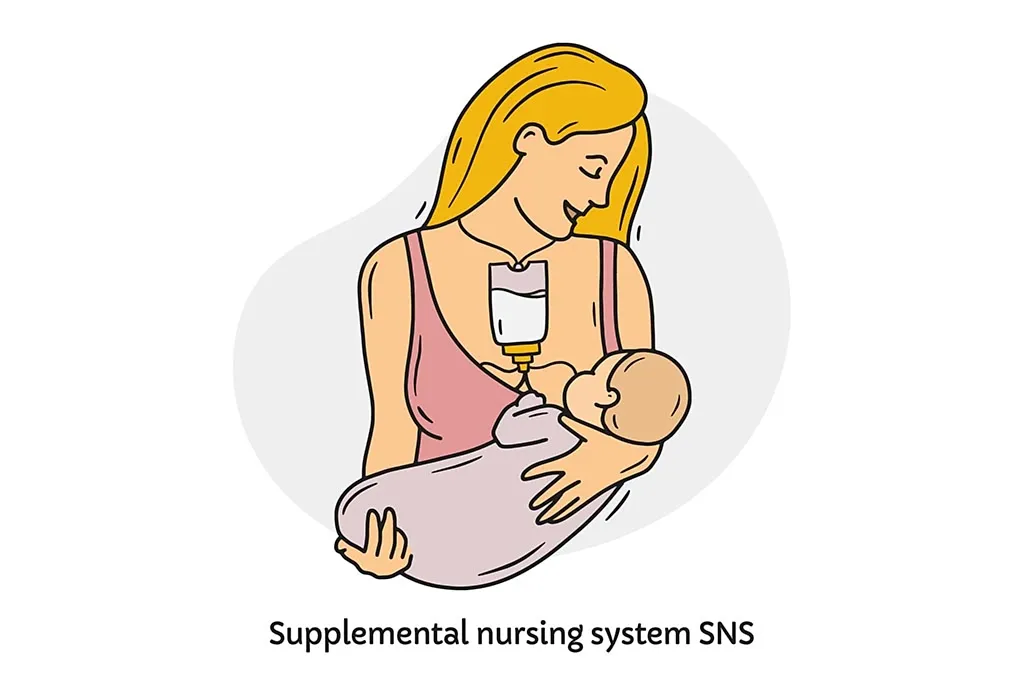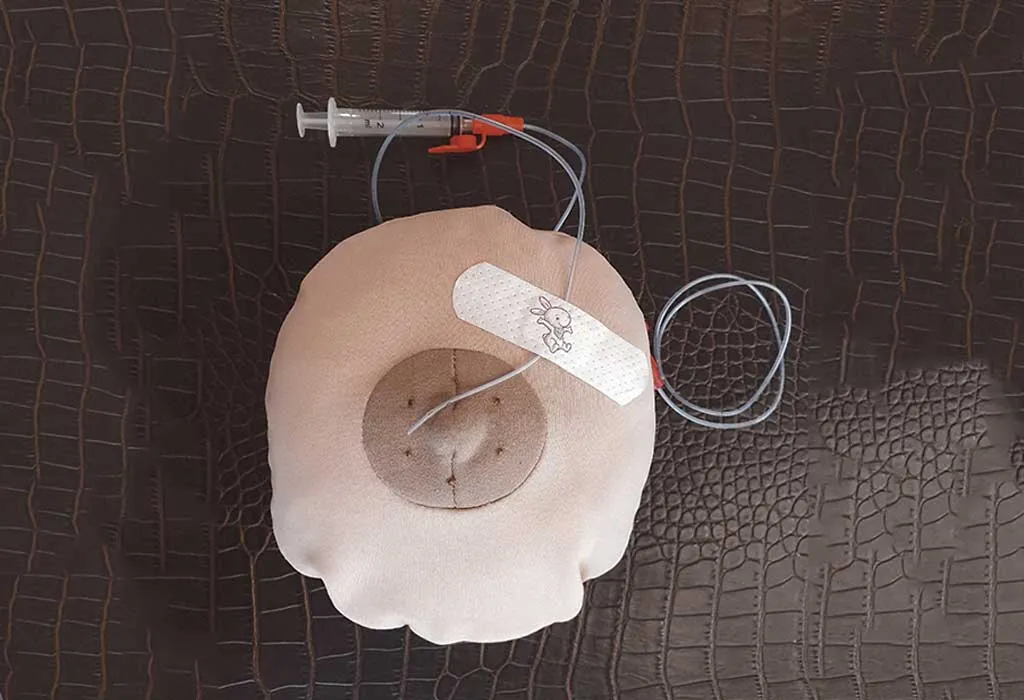Supplemental Nursing System (SNS): Benefits, Types & How to Use
Breastfeeding is a beautiful way to bond with your baby, but it doesn’t always go as smoothly as we hope, and that’s completely okay! If you’re facing challenges like a low milk supply or have a baby who needs a little extra help feeding, a Supplemental Nursing System (SNS) might be just what you need. This simple yet powerful tool allows your baby to get extra milk, whether it’s formula or expressed breast milk, while still nursing at your breast. Confused? Don’t be! Keep reading; in this article, we’ll break it all down for you: what an SNS is, how it works, the different types available, and how to use it.
What Is Supplemental Nursing System?

A Supplemental Nursing System (SNS) is a special feeding device that helps babies receive extra milk like breast milk or formula while they breastfeed at the breast. It typically consists of a small container or bottle that holds the milk and thin, flexible tubes that are taped near the mother’s nipple. As the baby latches and suckles, they draw milk from both the breast and the tube at the same time (1).
Benefits of Using an SNS System
Using a Supplemental Nursing System (SNS) can be a game-changer for parents and babies who need a little extra support during breastfeeding. Here are a few benefits of using SNS feeding:
1. Supports Breastfeeding and Milk Supply
An SNS encourages the baby to suck at the breast, which stimulates the mother’s milk production. This is especially helpful for mothers with low milk supply or those trying to re-lactate (2).
2. Provides Adequate Nutrition for Baby
With an SNS, your baby can receive extra milk, either formula or expressed breast milk, while breastfeeding. This ensures they’re getting enough to grow and thrive without having to switch to bottle feeding entirely.
3. Strengthens the Mother-Baby Bond

Because the baby is still feeding at the breast, an SNS allows for skin-to-skin contact, eye contact, and the comfort that comes with nursing, helping maintain a strong emotional connection.
4. Useful for Adoptive or Surrogate Mothers
An SNS offers a way for adoptive, surrogate, or non-birth mothers to experience breastfeeding by supplying milk through the system while the baby suckles at the breast, encouraging bonding and sometimes even stimulating milk production (3).
When Is It Used?
A SNS breastfeeding can be a helpful tool for parents who want to support or continue breastfeeding when challenges arise. Here are a few situations where a supplemental nursing system might be helpful:
- To Boost Milk Supply: If your baby isn’t getting enough from breast milk alone, a nursing supplementer device can help. It lets your baby feed at the breast while also getting extra milk. This is helpful if you have a low milk supply or have had breast surgery, which makes it harder to produce enough milk (3).
- When Trying to Start Lactation: If you’re hoping to begin producing milk without having been pregnant, such as in cases of adoption or surrogacy, a supplementing system can support this process. Having your baby suckle at the breast, even with supplemental milk, may help trigger your body to start making milk and deepen your emotional connection.
- If Your Baby Started on Bottles Due to Medical Issues: Babies born prematurely or with certain health concerns may start with bottle feeding. A supplemental nursing system can help shift toward breastfeeding or preserve that bond while your baby gains the strength to nurse directly (4).
Types of Nursing Supplemental System
Not all Supplemental Nursing Systems (SNS) are the same; different types are designed to suit different needs and comfort levels. Whether you’re looking for a reusable option or something quick and simple for short-term use, there’s a system out there that can help support your breastfeeding goals. Here are some common types of SNS devices:
1. Homemade or DIY Systems
For those just starting out with supplemental nursing, a homemade version can be a simple and cost-effective way to try it out. You can use a baby bottle fitted with a rubber nipple and a small infant feeding tube, which many nurses or lactation consultants have readily available. To set it up, gently cut a slit in the nipple and guide the tube through so it reaches the milk inside the bottle. A vent or extra hole in the nipple helps milk flow more easily for your baby.
2. Disposable Bag System
This system includes pre-sterilised disposable bags that hold milk or formula. The bags are lightweight and hang from a loop worn around your neck, keeping them close to the breast during feeding. A thin tube connects from the bag to the baby’s mouth, allowing milk to flow only when the baby is actively nursing.
3. Bottle System
The reusable bottle option includes one or two bottles with feeding tubes, which makes switching sides during feeding easier. These bottles and tubes can be washed and reused, making them a more environmentally friendly choice. Tubes often come in different sizes, so you can adjust the milk flow based on your baby’s needs. Small clamps let you pause and restart milk flow when needed, giving you more control during feeding sessions.
How to Use Breastfeeding Supplemental Nursing System?

Using a Supplemental Nursing System (SNS) may feel a little tricky at first, but with a bit of practice, it becomes a natural part of your feeding routine. Here’s a simple step-by-step guide to get you started (1):
- Start by filling the SNS container with expressed breast milk, formula, or a mix of both, depending on your baby’s needs and your feeding plan.
- Attach the thin feeding tube to the container, and carefully tape or place the other end near your nipple so that it runs along your breast. The tip should be just at the end of your nipple where the baby latches.
- Make sure the container is positioned slightly above the baby’s mouth (such as clipped to your clothing) so the milk flows easily through the tube. Some systems use gentle suction instead.
- Gently help your baby latch onto the breast with the tube in place. It may take a few tries, so stay patient and calm; your baby will get the hang of it.
- If the milk isn’t flowing or the baby unlatches, reposition the tube or adjust the angle of the container. A lactation consultant can help with troubleshooting if needed.
- After each use, wash all parts of the SNS with warm, soapy water and follow the manufacturer’s cleaning instructions to keep everything safe and hygienic for your baby.
How to Create SNS at Home?
If you’re looking for a temporary or cost-effective solution, you can create a DIY Supplemental Nursing System at home using simple, safe materials. DIY SNS breastfeeding can be a helpful way to supplement feeding while still breastfeeding (5).
What Will You Need?
- A small, clean container
- A thin feeding tube (No. 5 or 6 French catheter works well)
- Tape or medical adhesive
- Nipple with a small hole
Instructions
- Make sure the bottle, tube, and any tools are clean and sterilised before each use to keep the system safe for your baby.
- Pour the expressed breast milk or formula into the bottle or container you’re using.
- Place one end of the feeding tube into the milk container, making sure it reaches the bottom so milk flows easily.
- Tape the other end of the tube along your breast so the tip sits just past your nipple, where your baby will latch.
- Hold or clip the container slightly above your breast level to allow milk to flow through the tube.
- Help your baby latch onto the breast with the tube in place.
Tip: DIY systems are best used under the guidance of a lactation consultant to ensure safety and proper technique.
FAQs
1. When should I start using a supplemental nursing system?
You can begin using an SNS as soon as it’s clear your baby needs extra milk, and you want to continue breastfeeding. This might be in the first days after birth if your supply is low or later on if you’re working to increase supply or resume breastfeeding. It’s best to get guidance from a lactation consultant to know the right time.
2. Will using an SNS confuse my baby?
Unlike bottle feeding, an SNS allows babies to continue suckling at the breast, which helps maintain their natural latch and feeding behaviour. This reduces the risk of nipple confusion and supports the transition back to full breastfeeding if that’s your goal.
3. Can I reuse the feeding tubes in an SNS?
That depends on the type of system you’re using. Tubes from commercial reusable systems can be cleaned and sterilised according to the manufacturer’s instructions. However, tubes used in homemade systems (like hospital-grade feeding tubes) aren’t designed for multiple uses and should be replaced when they become stiff or discoloured.
Trying a supplemental nursing system might seem tricky at first, but it’s just another tool to help you feed your baby in a way that works for both of you. There’s no one “right” way to breastfeed, and what matters most is that your baby is fed, growing, and loved.
References/Resources:
1. Kaiser Permanente – Using the Supplemental Nursing System (SNS) at the Breast
2. La Leche League GB – Nursing Supplementers
3. International Journal of Advances in Nursing Management – A Supplemental Nursing System (SNS)
5. THE BREASTFEEDING CENTER – How to DIY a Supplemental Nursing System at home
Also Read:
Nursing Pillow
Breastfeeding With Flat or Inverted Nipples
Myths & Facts About Breastfeeding Your Baby
Comfort Nursing: How Beneficial It Is for Your Baby?
Breastfeeding With Hypoplastic (Tubular) Breasts
Was This Article Helpful?
Parenting is a huge responsibility, for you as a caregiver, but also for us as a parenting content platform. We understand that and take our responsibility of creating credible content seriously. FirstCry Parenting articles are written and published only after extensive research using factually sound references to deliver quality content that is accurate, validated by experts, and completely reliable. To understand how we go about creating content that is credible, read our editorial policy here.






















